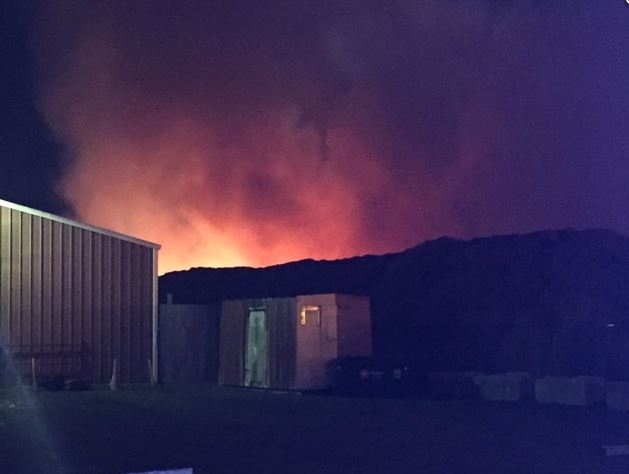Update as of 2/20/17 at 1630
DON
PEDRO CONTROLLED SPILLWAY GATES ARE NOW OPEN
Turlock
Irrigation District opened one of three Controlled Spillway Gates at Don Pedro
Reservoir today at 3 p.m. This was a result of the size and magnitude of the
current storm, which forecasted Don Pedro Reservoir to exceed its maximum
capacity of 830 feet.
The
Controlled Spillway Gate is operating as designed and onsite technical experts
continue to monitor operations. The Dam and spillway structures undergo regular
inspections and testing and the structural integrity of the project remains
sound.
Landowners,
growers and those living along the Tuolumne River, out of an abundance of
caution, should undertake necessary steps to protect their property and
livestock as Tuolumne River levels will rise quickly.
The
initial water releases to the Tuolumne River are expected to be approximately
18,000 cubic feet per second (cfs) which equates to about 60 feet as measured
at the 9th
Street
Bridge at Modesto. However, the releases could increase due to the amount of
inflow entering the reservoir.
It
takes approximately 23 hours for the releases from Don Pedro to reach the 9th Street Bridge at
Modesto. Please note that those in closer proximity to Don Pedro Reservoir will
see increased flows earlier. These releases will continue for a minimum of four
days.
TID
will provide frequent updates through the duration of the event. TID is
partnering with the Stanislaus County Sheriff’s Office, which is also providing
regular updates via their website at www.scsdonline.com/info/press-releases-via-nixle.html.
Scheduled
Electrical Outages: In
the interest of electrical safety near the River, TID and Modesto Irrigation
District began de-energizing power lines along the Tuolumne River channel
earlier today. Power will be restored when safe.
Bonds
Flat Road Closure: Bonds
Flat Road is closed beyond Fleming Meadows and Blue Oaks campgrounds to public
access to ensure the safety of the public and spillway operations.
Don
Pedro Recreation Agency: The Lake will be closed for boaters during the use of
the spillway gates. For more information about lake operations visit www.donpedrolake.com
Register
for Emergency Alerts: Those in Stanislaus and Merced counties are encouraged
to register for emergency notifications from their respective county;
Stanislaus County residents at StanAware.com and Merced County
residents at CountyofMerced.com/alert.
Additional
Information: TID
will continue to provide updates as necessary. Please visit tid.org/flows
for
more information. You can also view Don Pedro levels and Tuolumne River
releases at tid.org/water/hydrological-data. For information about River water
level and flows at 9th Street in
Modesto, visit the National Weather Service
page at http://www.c6y7y7566y7nrfc.noaa.gov/graphicalRVF.php?id=MDSC1.
Register for Emergency Alerts from your County
o Stanislaus County: StanAware.com
o Merced County: CountyofMerced.com/alert
General Emergency Information:
o http://www.stanemergency.com/
How to obtain sandbags:
o In Stanislaus County: http://www.stanemergency.com/naturalDisasters/weather.shtm
o In Merced County: http://www.co.merced.ca.us/DocumentCenter/Home/View/2680
Established
in 1887, Turlock Irrigation District serves reliable and affordable water and
power to much of California's Central Valley.
=======
Don Pedro Reservoir
TID is proud to serve the local community by maintaining the Don
Pedro Reservoir. The reservoir provides irrigation water storage for
local growers, as well as power generation, flood control and recreation
for other local citizens.
The First Don Pedro Reservoir
In
1923, Turlock and Modesto Irrigation Districts joined forces to build
the first Don Pedro Dam, which had a storage capacity of 289,000 acre
feet. The dam held barely enough water to accommodate growers'
irrigation needs for a single growing season.

The New Don Pedro Reservoir
New
Don Pedro Dam construction began in 1967 and was completed in 1971 at a
cost of $105 million. The reservoir has a capacity of 2,030,000 acre
feet, substantially increasing TID's water storage capacity on the
Tuolumne River.
Dam statistics:
- 580 Feet high
- 855 Feet above sea level at the crest
- 1900 Feet at crest length
- 40 Feet wide at crest
- 2800 Feet wide at its base
Irrigation
TID uses water stored in Don Pedro to irrigate approximately 5,800 farms within our 307 square-mile irrigation service area.
Power
TID
has been delivering power to retail customers since 1923. As an
operating partner, TID operates the powerhouse at the reservoir, which
can generate up to 203 megawatts of electric power from its four
generators.
Flood Control
Don Pedro Lake also provides
flood protection for the valley below. Don Pedro's immense capacity is
able to absorb surges from Sierra storms to protect property, farmland
and industry.
Recreation
With 160 miles of shoreline and
nearly 13,000 acres of surface area (at maximum lake level), visitors
can enjoy boating, fishing, water sports, swimming and camping. One of
the highlights of the year is the annual Fourth of July fireworks show.
For more information, call the Don Pedro Recreation Area at (209) 852-2396 or visit the Don Pedro Lake website.
Relicensing
The
Reservoir is licensed by the Federal Energy Regulatory Commission and
jointly held by TID and the Modesto Irrigation District (MID). By virtue
of their historic sharing agreement based on acreage served within each
district, TID's share and interest in the dam amounts to 68.46 percent
while the MID's share is 31.54 percent. The current license will expire
in 2016. Learn more about the relicensing by visiting the Don Pedro Relicensing website.
The
Reservoir is crucial to our water system and TID is taking every step
to ensure the relicensing process will be successful. This is a long,
arduous and expensive process that will focus, in large part, on
instream flow releases and fisheries habitat below Don Pedro Reservoir.





























